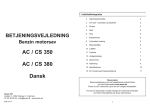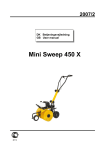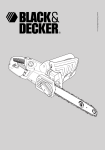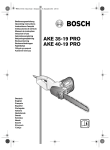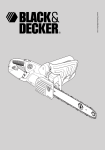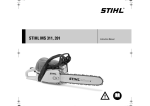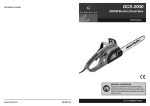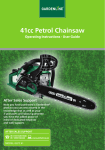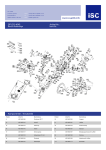Download Users manual
Transcript
1. Indholdsfortegnelse 2. Sikkerhedsforskrifter 3 3. Montering af sværd og kæde 5 4. Kædeolie 5 5. Start / stop 5 BETJENINGSVEJLEDNING 6. Kædebremse 6 7. Vedligeholdelse 6 Elektrisk motorsav 8. Specifikationer 7 9. EU-overensstemmelseserklæring 8 Model 1600-35 Model 1800-40 Reservedele Reservedelstegning over det pågældende produkt findes på vores hjemmeside www.texas.dk Finder du selv varenumre, giver det en hurtigere ekspedition. For køb af reservedele, kontakt venligst din nærmeste forhandler. Du finder forhandlerliste på Texas' hjemmeside Dansk Texas A/S Knullen 2 - 5260 Odense S - Danmark Tlf. 63 95 55 55 - [email protected] - www..texas.dk 6096-211018 2 2. Sikkerhedsforskrifter - Læs denne betjeningsvejledning grundigt, dermed du forstår og kan følge alle sikkerhedsforskrifter og betjeningsfunktioner fuldstændigt, før du går i gang med at arbejde med maskinen. - Kædebremsen er monteret for at beskytte mod "kast", som er en hurtig opadgående bevægelse i sværdet. Dette kan forekomme, hvis sværdspidsen rammer fremmedlegemer. Det er derfor vigtigt, at du er opmærksom på, at kædebremsen virker korrekt. - Børn må ikke bruge saven. - Hvis du føler dig syg, træt, eller har indtaget alkohol eller medicin, må du ikke arbejde med motorsaven. - Hold kædesaven fast med begge hænder, og hold den så tæt ind til dig, at du hele tiden har kontrol over den. - Brug altid sikkerhedsfodtøj, sikkerhedsbukser, beskyttelsesbriller, høreværn samt sikkerhedshjelm. - Lad motorkroppen ligge mod træet, mens du saver. - Undgå at save med sværdspidsen og kontroller at sværdspidsen ikke rammer noget, mens du saver. - Sørg for at eventuelle tilskuere er mindst 10 meter fra det sted, hvor du starter / arbejder med kædesaven. - Sav ikke med kædesaven over skulderhøjde. - Begynd aldrig at save før: - Følg instruktionerne for filning og vedligeholdelse i denne betjeningsvejledning. - Arbejdsområdet er ryddet. - Du har sikkert fodfæste. - Du har vurderet hvor træet vil falde hen. - Hold om kædesavens håndtag med begge hænder og med tommelfingeren under forreste bøjle. - Hold kædesaven væk fra kroppen. - Før du starter kædesaven, skal du kontrollere, at kæden ikke er i kontakt med noget. - Stop altid motoren når du stiller kædesaven fra dig. Sørg for at sværd og kæde vender bagud, når du bærer maskinen. - Undersøg din kædesav for slidte, løstsiddende eller ødelagte dele, spænd bolte og møtrikker efter. Maskinen bør ikke anvendes før den er i korrekt og sikkerhedsmæssig stand. - Vær ekstra forsigtig når du saver i buske og små træer. Små grene kan gribe fat i kæden og blive slynget imod dig eller få dig til at miste balancen. - Sørg for at håndtagene er rene, og at der ikke er rester af olie. - Arbejd kun med kædesaven udendørs. - Arbejd kun med træfældning, hvis du er specielt uddannet til det. - Alle reparationer, som ikke er beskrevet i denne betjeningsvejledning, må kun udføres af specieluddannet personale på et autoriseret serviceværksted. Brug af forkert værktøj kan ødelægge din kædesav. 3 4 3. Montering af sværd og kæde 6. Kædebremse 1. Afmonter sidedækslet. 2. Læg kæden rundt om næsehjulet på sværdet. Når kæden har godt fat i næsehjulet sættes sværdet ind på motorenheden, og kæden lægges i sværdet. Fig 3D 3. Vær opmærksom på at kæden vender den rigtige vej. Fig 3C 4. Monter sidedækslet. Fig. 3E 5. Spænd møtrikkerne til med fingerne. 6. Løft i sværdspidsen, og stram kæden op ved hjælp af strammerbolten. Kæden skal være så stram, at man lige netop kan løfte drivleddet fri af sporet i sværdet. Fig 5B 7. Spænd sværd og sidedæksel forsvarligt til. Fig 5A Næsehjul findes kun på model 1800-40 D Fig. 3C F H G Fig. 3D Fig. 3E G A B Fig. 3C Fig. 3C 4. Kædeolie Brug altid kædeolie til smøring af sværd og kæde. Almindelig motorolie er ikke egnet hertil. Vi anbefaler Texas Klingetex 125. Påfyld olie her For yderligere smøring kan man benytte smørehullet på sværdets spids. Brug en engangssprøjte og kom olie i smørehullet, samtidig med at man trækker i kæden. Fig. 6 Sørg altid for at strømmen er frakoblet og at kædebremsen er deaktiveret. Næsehjul findes kun på model 1800-40 Fig. 14 Test kædebremsen på følgende måde. 1. Placer saven på et fast underlag. 2. Start motoren. 3. Hold med højre hånd på bagerste håndtag. Fig. 9A Fig. 9B 4. Hold med venstre hånd på forreste håndtag. 5. Giv gas og aktiver kædebremsen 6. Kæden skal øjeblikkeligt stoppe. Når den stopper, frigiv gassen. 7. Hvis kædebremsen virker, stop maskinen og placer kædebremsehåndtaget i deaktiveret position. 7. Vedligeholdelse Smørehul. Afmonter sværd og kontroller om smørehullet er stoppet med savsmuld eller snavs. Sværd. Rens næsehjul og løbegang for snavs. Vend evt. sværdet for at fordele sliddet. Et slidt sværd kan være farligt at anvende og bør derfor udskiftes. Kun model 1800-40. Fig. 14 Fig. 15 Kæde. Kæden bør files jævnligt for at opnå det bedste resultat samt for at nedsætte slidtage på el-motoren. 1. Sørg for at sværdet er spændt godt fast. 2. Brug en 4 mm fil. 3. Fil alle tænderne og dybdegrænserne Fig. 25 Fig. 26 indefra, som vist på tegningen. 4. Det er nødvendigt jævnligt at efterse højden af tænderne, hvis de er for høje, bør de files ned. Hvis du er i tvivl, bør du kontakte din Texas forhandler. Fig. 24 Brug kun originale reservedele 5. Start / stop 1. Saven startes ved at aktivere "start" kontakten. 2. Kontakten på håndtagets venstre side skal holdes inde, før saven kan startes. 3. Ligeledes stoppes saven ved at frigive kontakten. 5 START Del Skruer / bolte Olieniveau Kædebremse Efter hver brug Tjek / stram Tjek Tjek Udskift Hver 10 køretime X X X Hvis nødvendigt 6 Hver20 køretime 8. Specifikationer Model Motoreffekt Omdrejninger Tankindhold Smøring Anti-vibration Vægt Sværdtype Kædebremse Håndskærm Barksted Kæde Varenummer 9. EU overensstemmelseserklæring Kædesav 1600-35 230 V, 1600 Watt 6.000 - 7.000 / min 200 ml Automatisk Ja 4,3 kg 14"/35 cm Ja Ja Ja 49 led 40-109 Kædesav 1800-40 230 V, 1800 Watt 6.000 - 7.000 / min 200 ml Automatisk Ja 4,4 kg 16"/40 cm, næsehjul Ja Ja Ja 55 led 40-260 EU-importør Texas Andreas Petersen A/S Erklærer herved at materiel: • El-kædesav AC211116TD (Kædesav 1800-40) 1800 watt • El-kædesav AC211014TD (Kædesav 1600-35) 1600 watt er fremstillet i overensstemmelse med følgende direktiver: 98/37/EC Maskindirektivet 73/23/EEC Lavspændingsdirektivet 89/336/EEC EMC direktivet Materiellet er udført i henhold til følgende standarder: EN 50144, EN 55014-1, EN 55014-2, HD 400.3, EN 61000-3-2, EN 61000-3-3 Texas Andreas Petersen A/S Knullen 2 5260 Odense S Verner Hansen Administrerende direktør 16.08.2004 7 8 1. Innehåll BRUKSANVISNING Elektrisk kedjesåg 2. Säkerhetsföreskrifter 11 3. Montering av svärd och kedja 13 4. Kedjeolja 13 5. Start/stopp 13 6. Kedjebroms 14 7. Underhåll 14 8. Specifikationer 15 9. EC Överenskommelseförklaring 16 Model 1600-35 Model 1800-40 Svenska Texas A/S Knullen 2 - DK-5260 Odense S - Danmark Tel. +45 63 95 55 55 - [email protected] 8 10 2. Säkerhetsföreskrifter - Läs den här bruksanvisningen noggrant, så du förstår och kan följa alla säkerhetsföreskrifter och användningsinstruktioner fullständigt, innan du börjar arbeta med maskinen. - Barn får inte använda sågen. - Om du känner dig sjuk, trött eller om du har förtärt alkohol eller medicin ska du inte använda motorsågen. - Använd alltid skyddsskor, skyddsbyxor, skyddsglasögon, hörselskydd samt hjälm. - Tillse att alla andra personer befinner sig minst 10 meter från den plats där du startar / arbetar med motorsågen. - Börja aldrig såga förrän: - Håll motorsågen i ett fast grepp med båda händerna, och håll den på ett lagom nära avstånd, så att du alltid har kontroll över den. - Låt motorkroppen ligga an mot träet medan du sågar - Såga inte med svärdsspetsen, och kontrollera att svärdsspetsen inte träffar något medan du sågar. - Såga inte med motorsågen högre än axelhöjd. - Följ anvisningarna om filning och underhåll i den här bruksanvisningen. - Arbetsområdet är rensat. - Du har säkert fotfäste. - Du har planerade flyktvägar från fallande träd. - Håll motorsågens handtag med båda händerna med tummen under den främre bygeln. - Håll motorsågen riktad bort från kroppen. - Innan du startar motorsågen - kontrollera att kedjan inte är i kontakt med något. - Stäng alltid av motorn när du ställer ifrån dig motorsågen. Håll alltid svärdet och kedjan riktade bakåt när du bär maskinen. - Kontrollera att motorsågen inte har några slitna, löst sittande eller trasiga delar, dra sedan åt skruvar och muttrar. Maskinen ska inte användas förrän den är i korrekt och säkerhetsmässigt skick. - Var extra försiktig när du sågar i buskar och småträd. Små grenar kan fastna i kedjan och kastas emot dig, eller få dig att tappa balansen. - Kontrollera att handtagen är rena och att det inte finns några oljerester. - Arbeta bara utomhus med motorsågen. - Om du ska arbeta med trädfällning måste du ha särskild utbildning till det. - Reparationer som inte finns beskrivna i bruksanvisningen måste alltid utföras av specialutbildad personal på en auktoriserad serviceverkstad. Användning av felaktigt verktyg kan förstöra motorsågen. - Kedjebromsen är monterad för att skydda mot "kast", d.v.s. en snabbt uppåtriktad rörelse i svärdet. Detta kan inträffa om svärdsspetsen träffar något främmande föremål. Det är därför mycket viktigt att du alltid ser till att kedjebromsen fungerar korrekt. 11 12 3. Montering av svärd och kedja 1. Demontera sidoskyddet. 2. Lägg kedjan runt om kedjehjulet på svärdet. När kedjan har greppat kedjehjulet riktigt sätter du in svärdet i motorenheten, och lägger på kedjan på svärdet. Fig. 3D 3. Var noga med att kedjan vänds på rätt håll. Fig. 3C 4. Montera sidoskyddet. Fig. 3E 5. Spänn muttrarna med fingrarna. 6. Lyft i svärdsspetsen, och spänn kedjan med hjälp av spännskruven. Kedjan ska vara så spänd att man bara precis kan lyfta kedjelederna av spåret på svärdet. Fig. 5B 7. Dra åt svärdet och sidoskyddet ordentligt. Fig. 5A Noshjul findes kun i model 1800-40 6. Kedjebroms Testa kedjebromsen så här: 1. Ställ sågen på ett fast underlag. 2. Starta motorn. 3. Håll höger hand på det bakre handtaget. 4. Håll vänster hand på det främre handFig. 9A Fig. 9B taget. 5. Gasa och aktivera kedjebromsen. 6. Kedjan ska stanna omedelbart. Släpp gasen när den stannar. 7. Om kedjebromsen fungerar, stoppa maskinen och ställ kedjebromshandtaget i inaktiverat läge. D Fig. 3C F H G Fig. 3D Fig. 3E G A B Fig. 3C Fig. 3C 4. Kedjeolja Använd alltid kedjeolja för att smörja svärd och kedja. Vanlig motorolja är inte lämplig för detta. Använd TEXAS Klingetex 125. Vid ytterligare smörjning kan man använda smörjhålet på svärdsspetsen. Använd en engångsspruta och lägg olja i smörjhålet samtidigt som du drar i kedjan. Se alltid till att strömmen är urkopplad och att kedjebromsen är avstängd. Noshjul findes kun i model 1800-40 Påfyld olie her Fig. 6 Fig. 14 7. Underhåll Smörjhål. Demontera svärdet och kontrollera om smörjhålet är igensatt med sågspån eller smuts. Svärd. Rengör noshjulet och löpskenan så att det inte sitter kvar någon smuts. Eventuellt kan svärdet behöva vändas för att slitaget ska fördelas. Ett slitet svärd kan vara Fig. 14 Fig. 15 farligt att använda, och bör därför bytas ut. Kun model 1800-40. Kedja. Kedjan bör filas med jämna mellanrum för att man ska få bästa resultat. 1. Kontrollera att svärdet är ordentligt fastspänt. Fig. 25 Fig. 26 2. Använd en 4 mm fil. 3. Fila alla tänderna och djupgränserna inifrån, så som figuren visar. 4. Man måste kontrollera tandhöjden med jämna mellanrum. Om de är för höga ska Fig. 24 de filas ner. Om du är tveksam om något bör du kontakta din Texas-återförsäljare. Använd endast originalreservdelar 5. Start/stopp 1. Starta sågen genom att aktivera "start"-omkopplaren. 2. Omkopplaren på handtagets vänstra sida ska hållas inne innan det går att starta sågen. 3. På motsvarande sätt stoppar du sågen genom att släppa omkopplaren. 13 START Del Skruvar / bultar Oljenivå Kedjebroms Efter varje användning Kontrollera / spänn Kontrollera Kontrollera Byt ut Var 10:e körtimme X X X Vid behov 14 Var 10:e körtimme 8. Specifikationer Modell Motoreffekt Varvtal Tanken rymmer Smörjning Vibrationsskydd Vikt Svärdstyp Kedjebroms Handskärm Barkstopp Kedja Artikelnummer 9. EC Överenskommelseförklaring Kedjesåg 1600-35 230 V, 1600 watt 6 000 - 7 000 / min 200 ml Automatisk Ja 4,3 kg 14 tum/35 cm Ja Ja Ja 49 leder 40-109 Kedjesåg 1800-40 230 V, 1800 watt 6 000 - 7 000 / min 200 ml Automatisk Ja 4,4 kg 16 tum/40 cm, noshjul Ja Ja Ja 55 leder 40-260 EU-importør Texas Andreas Petersen A/S Undertecknad förklarar på företagets vägnar att: • El-kædesav AC211116TD (Kedjesåg 1800-40) 1800 watt • El-kædesav AC211014TD (Kedjesåg 1600-35) 1600 watt Uppfyller EU - direktiver: 98/37/EC 73/23/EEC 89/336/EEC Maskindirektiv lågspänningsdirektiv EMC direktiv Materiellet er udført i henhold til følgende standarder: EN 50144, EN 55014-1, EN 55014-2, HD 400.3, EN 61000-3-2, EN 61000-3-3 Texas Andreas Petersen A/S Knullen 2 5260 Odense S Danmark Verner Hansen Adm. Direktør 16.08.2004 15 16 GENERALSAFETY RULES Meaning of symbols marked on the product Warning! Danger Read the user manual before using the machine Whenever the machine is in use, safety goggles must be worn to safeguard against flaying object, as must ear protectors, such as a soundproof helmet, in order to protect the operator’s hearing. If the operator is working in an area where there is a risk of falling objects, a safety helmet must also be worn. Do not expose to rain Remove plug from the mains immediately if cable is damaged or cut Wear safety boots to protect against electric shock Wear gloves to protect your hands USER MANUAL Electric Chain Saw WARNING! When using electric tools, basic safety precautions, including the following, should always be followed to reduce the risk of fire, electric shock and personal injury. Read all these instructions before operating this product and save these instructions. 1. 2. Model 1600-35 Model 1800-40 3. 4. English 5. 6. 7. Texas A/S Knullen 2 - 5260 Odense S - Danmark Tlf. 63 95 55 55 - [email protected] - www..texas.dk 17 8. Keep work area clean Cluttered areas invite injuries. Do not start cutting until you have a clear work area, secure footing, and a planned retreat path from the falling tree. Consider work area environment Use extreme caution when cutting small sized brush and sapling, as slender material may catch the saw chain and be whipped toward you or pull you off balance. Do not operate a chain saw in a tree unless you are specifically trained to do so. When cutting a limb that is under tension, be alert for spring back so that you will not be struck when the tension in the wood fibers is released. Do not expose the chain saw to rain. Do not use the chain saw in damp or wet locations. Do not use the chain saw in the presence of flammable liquids or gases. Store idle chain saw When not in use, tools should be stored in a dry, high or locked up place, out of reach of children. Do not force the chain saw The chain saw will do a better and safer job when used at the rate for which it was intended. Use the right tool Cut wood only. Do not use the chain saw for purposes for which it was not intended. For example, do not use the chain saw for cutting plastic, masonry, or non-building materials. Dress properly Do not wear loose clothing or jewelry, as they can get caught in moving parts. Non-skid footwear is recommended when working outdoors. Wear protective hair covering to contain long hair. Use safety gear Use safety glasses, safety footwear, snug fitting clothing, protective gloves, and protective hearing and head gear. Carrying the saw Carry the saw by the front handle with the saw stopped. Keep your finger off the switch, and make sure that the guide bar and saw chain are to the rear. 9. 10. 11. 12. 13. 14. 15. 16. 17. 18 Do not abuse the cord Never carry the tool by the cord or yank it to disconnect it from the socket. Keep the cord away from heat, oil and sharp edges. Secure work Use clamps or a vice to hold the work. Do not overreach Keep proper footing and balance at all times. Maintain the chain saw with care Inspect the chain saw cords periodically and, if damaged, have them repaired by an authorized service facility. Keep the cord clear of the chain and operator at all times. Never carry the saw by the cord or pull it to disconnect from receptacle. Keep the cord from oil and sharp edges. Inspect the extension cords periodically and replace if damaged. Keep tools sharp and clean for better and safer performance. Follow instructions for lubricating and changing accessories. Keep handles dry, clean and free from oil and grease. Disconnect the chain saw Disconnect the chain saw when not in use, before servicing, and when changing accessories and attachments such as saw chain and guard. Remove adjusting keys and wrenches Form the habit of checking to see that keys and adjusting wrenches are removed from the tool before turning it on. Avoid unintentional starting Do not carry a plugged-in tool with a finger on the switch. Ensure switch is off when plugging in. Use outdoor extension leads Use only extension cords that are intended for outdoor use and which are so marked. Stay alert Watch what you are doing. Use common sense. Do not operate the chain saw when you are tired. Keep all parts of your body away from the saw chain when the motor is operating. Before you start the saw, make sure the saw chain is not contacting anything. 18. Check damaged parts Before further use of the tool, a guard or other part that is damaged should be carefully checked to determine that it will operate properly and perform its intended function. Check for alignment of moving parts, free running of moving parts, breakage of parts, mounting and any other conditions that may affect its operation. A guard or other part that is damaged should be properly repaired or replaced by an authorized service centre unless otherwise indicated in this instruction manual. Have defective switches replaced by an authorized service facility. Do not use the tool if the switch does not turn it on and off. 19. Warning! The use of any accessory or attachment, other than those recommended in this instruction manual, may present a risk of personal injury. 20. Have your tool repaired by a qualified person This electric tool is in accordance with the relevant safety requirements. Repairs should only be carried out by qualified persons using original spare parts, otherwise this may result in considerable danger to the user. 24. 25. 26. 27. 28. 29. 30. 31. 32. WARNING: Kickback may occur when the nose or tip of the guide bar touches an object, or when the wood closes in and pinches the saw chain in the cut. Tip contact in some cases may cause a lightning-fast reverse action, kicking the guide bar rapidly back towards the operator. Pinching the saw chain along the top of the guide bar may push the guide bar rapidly back towards the operator. Either of these reactions may cause you to lose control of the saw, which could result in serious injury to the user. The following precautions should be followed to minimize kickback. 33. 34. 35. 36. 37. 21. Guard against KICKBACK A. GRIP SAW FIRMLY: Hold the chain saw firmly with both hands when the motor is running. Keep a good firm grip on the saw with both hands, the right hand on the rear handle, and the left hand on the front handle. B. Do not over reach. C. Keep proper footing and balance at all times. D. Do not let the nose of the guide bar contact a log, branch, ground or other obstruction. E. Do not cut above shoulder height. F. Use devices, such as low-kickback chain, guide bar nose guards, chain brakes and special guide bars, which reduce the risks associated with kickback. G. Use only replacement bars and chains specified by the manufacturer or the equivalent. H. There are no other replacement components for achieving kickback protection in accordance with CSA Z62.3. 22. Power supply Connect the chain saw to correct voltage; be sure that the voltage supplied is the same as that specified on the nameplate of the tool. 23. DO NOT operate a chain saw that is damaged, 38. 39. 40. 41. 42. 19 improperly adjusted, or not completely and securely assembled. Be sure that the saw chain stops moving when the trigger is released. DO NOT attempt operations beyond your capacity or experience. DO NOT operate a chain saw with one hand! Serious injury to the operator, helpers, or bystanders may result from one-handed operation. A chain saw is intended for two-handed use. TO REDUCE potential for electric shock, do not operate the saw on wet or slippery surfaces, or during snow storms, rain storms, and other adverse weather conditions. Keep the handles dry, clean, and free of oil or grease. DO NOT allow dirt, debris or sawdust to build up on the motor or outside air vents. Follow the manufacturer’s sharpening and maintenance instructions for the saw chain. Cut at high motor speeds. Operation of a chain saw should be restricted to mature, properly instructed individuals. Your chain saw is intended for occasional homeowner use. It is not made for heavy continuous use. DO NOT FORCE a small saw to do a job requiring a heavier duty unit. Examine the electrical switches. Do not use the chain saw if the switches do not properly turn on and off. Do not attempt to make any repairs to the electric switches. Take your saw to a Texas Authorized Service Center. Maintain extension cords Inspect the extension cords periodically and replace if damaged. Only use power cords that are suitably marked for outdoor use. DO NOT operate your chain saw near or around flammable liquids or gases, whether in or out of doors. An explosion and/or fire may result. All chain saw service, other than the items listed in the user manual safety and maintenance instructions, should be performed by competent chain saw personnel. Do not attempt to repair it yourself; there are no user serviceable parts inside. NEVER REMOVE, modify or make inoperative any safety device furnished with your unit. The CHAIN BRAKE®/Hand Guard is a major safety feature. The saw will not run when the CHAIN BRAKE® is tripped. It is intended for infrequent use by homeowner’s, cottagers and campers, and for such general applications such as clearing, pruning, cutting firewood, etc. It is not intended for prolonged use. If the intended use involves prolonged periods of operation, this may cause circulatory problems in the user’s hands due to vibration. It may be appropriate to use a saw having an anti-vibration feature. Safety clothing required by your safety organizations, government regulations, or your employer should be used; otherwise, snug fitting clothing, safety footwear, and hand and ear protection should be worn. When felling, keep at least 2 tree lengths between yourself and your fellow workers. Keep everyone, especially children and pets, away from the area of operation. Never allow children to operate the appliance. Turn off unit immediately if you are approached. SPECIFICATIONS Model Motor No Load Speed Oil Capacity Cutting Speed Net Weight Cutting Length Barking Time Vibration Sound Power Level BASIC 1600-35 230 V, 1600 watt 6.000 - 7.000 / min 200 ml 12 m/sec 4,3 kg 14”/35cm 0.1s < 12.1 m/s2 107.0 dB(A) EXTRA 1800-40 230 V, 1800 watt 6.000 - 7.000 / min 200 ml 12 m/sec 4,4 kg 16”/40cm 0.1s < 12.1 m/s2 107.0 dB(A) IMPORTANT SAFETY • How to read symbols and colors (Fig. 1) A B WARNING: RED Used to warn that an unsafe procedure should not be performed. A A A B GREEN RECOMMENDED B Recommended cutting procedure. 1 2 3 4 Fig. 1 • C WARNING 1. Beware of kick back. 2. Do not attempt to hold saw with one hand. 3. Avoid bar nose contact. Fig. 2A Fig. 2B KICKBACK may occur when the NOSE or TIP of the guide bar touches an object, or when wood closes in and pinches the saw chain in the cut. Tip contact in some cases may cause a lightning-fast reverse reaction, kicking the guide bar up and back toward the operator. PINCHING the saw chain along the BOTTOM of the guide bar may PULL the saw forward, away from the operator. PINCHING the saw chain along the TOP of the guide bar may PUSH the guide bar rapidly back toward the operator. Any of these reactions may cause you to lose control of the saw, which could result in serious personal injury. RECOMMENDED 4. Hold Saw properly with both hands. DANGER! BEWARE OF KICKBACK! WARNING: Kickback can lead to dangerous loss of control of the chain saw and result in serious or fatal injury to the saw operator or to anyone standing close by. Always be alert because rotational kickback and pinch kickback are major chain saw operational dangers and the leading cause of most accidents. BEWARE OF: ROTATIONAL KICKBACK (Fig. 2A) A = Kickback path B = Kickback reaction zone THE PUSH (PINCH KICKBACK) AND PULL REACTIONS (Fig. 2B) A = Pull B = Solid objects C = Push 20 ASSEMBLY INSTRUCTIONS 3. INTRODUCTION This unit is designed for occasional homeowner use and should not be used for commercial purposes or subjected to heavy continuous use. Your new chain saw can by used for a variety of projects such as cutting firewood, making fence posts, felling small trees, limbing, pruning at ground level, and light carpentry. Cut only wood or wood products with your saw. TOOLS FOR ASSEMBLY Your User’s Kit may contain a combination wrench/screwdriver (wrench) and is the only tool you will need to assemble your unit and to adjust the saw chain tension. ASSEMBLY REQUIREMENTS Your new chain saw may require installation of the guide bar, saw chain, sprocket cover, adjustment of chain, and filling the oil tank with lubricating oil, before the unit is ready for operation. Do not start the saw motor until the unit is properly assembled. Read all instructions carefully. Do not install any other size bar and chain than what is recommended for your model. Install the sprocket cover (H). Place the cover over the 2 bar bolts. Thread the retaining nuts (J) FINGER TIGHT ONLY. (See Fig. 3E) H F G Oil Cap Fig. 3D Fig. 3E B • SAW CHAIN TENSION ADJUSTMENT Proper tension of the saw chain is extremely important and must be checked before starting, as well as during, any cutting operation. Taking the time to make needed adjustments to the saw chain will result in improved cutting performance and prolonged chain life. NOTE: A new chain and bar will need readjustment after as few as 5 cuts. This is normal during the break-in period, and the interval between future adjustments will lengthen quickly (Fig. 4). CAUTION: If a chain is TOO LOOSE or TOO TIGHT, the bar chain and saw bearings will wear more rapidly. Study Fig. 4 for information concerning correct cold tension (A), correct warm tension (B), and as a guide for when saw chain needs adjustment (C). CAUTION: If the chain is too loose, more than 3mm after applying down force with finger, as shown in Fig. 4. It needs to be adjusted, otherwise the stopping time might be over the limit. B Fig. 3A D Fig. 3B 2mm A To Install Saw Chain WARNING: Whenever handling the saw chain, wear work gloves for protection against sharp cutting edges. 1. 2. NOTE: Your chain saw is equipped with an Automatic Oiler system and is the ONLY source of lubrication for the bar and chain (Fig. 6) A A C CAUTION: The oil tank level should be frequently checked during operation to avoid starving the bar and chain of lubrication. C • GUIDE BAR/SAW CHAIN INSTALLATION To Install Guide Bar 1. Place power unit on flat surface and remove bar bolt nuts and sprocket cover. 2. Using a straight screwdriver or the scrench, if provided in your User’s Kit, turn the chain adjustment screw (A) counterclockwise as far left as it will go, or until the Tang (B) (projecting prong) is to the end of its travel. (See Fig. 3A) 3. Place the slotted end of the guide bar over the bar bolts so the Tang (B) fits into the lower hole C) in the guide bar (D). (See Fig. 3B) B We recommend using Texas Chain, Bar and Sprocket Oil, which contains additives to reduce friction wear and reduce resin residue formations. NOTE : IF the chain is difficult to rotate or if it binds on the guide bar, too much tension has been applied and must be adjusted. To decrease tension, turn the adjustment screw counterclockwise slowly. Move the chain back and forth until it moves freely. 4. Holding the nose in upper position, securely tighten the bar retaining nuts (70 inch lbs.) B < 2mm C Fig.4 To Adjust Saw Chain Tension: 1. Loosen the bar retaining nuts (J) so they are hand tight. (See Fig. 3A) 2. Holding the nose of the bar up, use the screwdriver or wrench if provided in your User’s Kit to turn the guide bar adjustment screw (F) (Fig. 3B) clockwise to tighten the chain. Turning the screw COUNTERCLOCKWISE LOOSENS THE CHAIN on the guide bar. 3. After adjustment and while wearing heavy duty work gloves, move the saw chain back and forth on the guide bar to be sure the chain moves freely and is in proper mesh with sprocket. Spread the chain out with E the cutting edges (E) of the chain pointing in the DIRECTION OF ROTATION. (See Fig. 3C) Place the chain over the sprocket (F) with drive links Fig. 3C fitting between sprocket teeth. Guide the chain links into the groove (G) on the top side of the guide bar and around the nose. The saw chain will droop slightly on the lower part of the guide bar. (See Fig. 3D) 21 Fig. 5A Fig. 5B • FILLING OIL TANK Using a funnel, fill oil tank with Texas Chain, Bar and Sprocket oil. Wipe up any spills. Make sure no dirt gets into the oil tank. The saw chain requires lubrication while in use to minimize friction with the guide bar. The oil tank holds 200ml of oil, enough to lubricate the chain for 15-20 minutes of sawing. Oil Tank Inspection Slot Fig. 6 OPERATION INSTRUCTIONS • TO START SAW 1. Make sure the chain brake IS DISENGAGED. The motor will not start if the chain brake is in the ENGAGED position. Disengage the chain brake by pulling backward toward the motor (Fig. 7A). WARNING: Ensure the extension cord is of the proper size and type for your saw. A Fig. 7A Fig. 7B C 2. An extension cord retainer is built into the switch handle that prevents the extension cord from pulling out of the handle. To use this feature, simply double the extension cord, about a foot from the end, and insert it into the end of the handle. Hook the loop formed by doubling the cord over the tab. Gently tug on the cord to ensure that it is firmly retained in the saws handle. Plug the receptacle end of the extension cord into the tool;s power supply cord. (Fig. 7B) 3. Grip the saw with both hands, left hand holding the front /handle (DO NOT HOLD CHAIN BRAKE ) and the right hand holding the rear handle. Thumbs and fingers should encircle both handles (Fig. 7C). 4. With your RIGHT THUMB, push the LOCK/OFF button (C) forward at end the top of the rear handle, and at the same time squeeze the trigger. To stop the saw, release the trigger (Fig. 7D). NOTE: It is not necessary to maintain pressure on the LOCK/OFF button once the trigger is squeezed and the motor is running. The LOCK/OFF button is a safety device to avoid accidental starting. • TO STOP MOTOR The saw motor will automatically stop when the trigger is released. The LOCK/OFF button will have to be depressed and the trigger squeezed to restart the motor. Fig. 7C Fig. 7D • CHAIN AND BAR LUBRICATION Adequate lubrication of the saw A chain during cutting operations is essential to minimize friction with the guide bar. Your chain saw is equipped with an automatic oiler system. The oiler automatically delivers the proper amount of oil to the bar and chain. There is no flow Fig. 8 adjustment. The oil tank level can be checked in the inspection window (A) provided on the right side of the saw. Tank is full when oil is at the top of the slot (Fig. 8). 22 The chain brake is engaged (chain cannot move) when the brake is in forward position (Fig. 9B). NOTE: The motor will not start if the chain brake is in the engaged position. CAUTION: Never starve the bar and chain of lubrication oil. Running the saw DRY or with TOO LITTLE OIL will decrease cutting efficiency, shorten chain saw life, and cause rapid dulling of the chain and excessive wear of the bar from overheating. Too little is evidenced by smoke or bar discoloration. NOTE: The saw chain stretches during use, particularly when it is new, and occasional adjustment will be needed. A new chain requires more frequent adjustment during the break-in period. This is normal. See Section for Saw Chain Tension Adjustment instructions. Fig. 9A CAUTION: A loose chain can jump off the bar while you are cutting, as well as wear the bar and chain. A chain that is too tight can damage the saw. Either situation, chain too loose or too tight, could cause serious personal injury. CHAIN BRAKE TEST Before cutting with your saw, the chain brake should be tested as follows: A. Make sure the chain brake is disengaged (Fig. 9A). B. Place the saw on a firm, flat, dry surface that is clear of any debris. Do not let the saw come in contact with any objects. C. Plug the unit into the power source. D. Grasp the front handle (not the Chain Brake / Hand Guard Lever) with your left hand. Thumb and fingers should encircle the handle. E. Grasp the rear handle with your right hand. Thumb and fingers should encircle the handle. F. Depress the LOCK/OFF button with your right thumb. Squeeze the trigger with your index finger. (Fig. 7D.) G. While the motor is running, activate the chain brake by rolling your left hand forward against the lever. H. Chain and motor should stop abruptly. WARNING: If the chain and motor fail to stop when the chain brake is engaged, take the saw to the nearest professional Service Center. Do not use the saw if the chain brake is not in proper working order. GENERAL CUTTING INSTRUCTIONS Fig. 10A FELLING A TREE: NOTE: Direction of fall (B) is controlled by the notching cut. Before any cuts are made, consider the location of larger branches and natural lean of the tree to determine the way the tree will fall. • FELLING Felling is the term for cutting down a tree. Small trees up to 15-18cm in diameter are usually cut in a single cut. Larger trees require notch cuts. Notch cuts determine the direction the tree will fall. WARNING: A retreat path (A) should be planned and cleared as necessary before cuts are started. The retreat path should extend back and diagonally to the rear of the expected line of fall, as illustrated in Fig. 10. B 23 1/4 3/4 E Fig. 11 Fig. 12A 2 1 C 3.5cm F D 1 Fig. 10B Fig. 12B WARNING: Never walk in front of a tree that has been notched. Make the felling cut (D) from the other side of the tree and 3-5cm above the edge of the notch (C) (Fig. 10B). Never saw completely through the trunk. Always leave a hinge. The hinge guides the tree. If the trunk is completely cut through, control over the felling direction is lost. Insert a wedge or felling lever in the cut well before the tree becomes unstable and starts to move. This will prevent the guide bar from binding in the felling cut if you have misjudged the falling direction. Make sure no bystanders have entered the range of the falling tree before you push it over. FELLING CUT: 1. Use wooden or plastic wedges (G) to prevent binding the bar or chain (H) in the cut. Wedges also control felling (Fig. 10C). 2. When diameter of wood being cut is greater than the bar length, make 2 cuts as shown (Fig. 10D). WARNING: As the felling cut gets close to the hinge, the tree should begin to fall. When tree begins to fall, remove saw from cut, unplug, put chain saw down, and leave area along retreat path (Fig. 10A). • BUCKING USING A SAWHORSE For personal safety and ease of cutting, the correct position for vertical bucking is essential (Fig. 13). VERTICAL CUTTING: A. Hold the saw firmly with both hands and keep the saw to the right of your body while cutting. B Keep the left arm as straight as possible. C. Keep weight on both feet. H A Fig. 10C 2 Fig. 12C • BUCKING Bucking is cutting a fallen log into lengths. Make sure you have a good footing and stand uphill of the log when cutting on sloping ground. If possible, the log should be supported so that the end to be cut off is not resting on the ground. If the log is supported at both ends and you must cut in the middle, make a downward cut halfway through the log and then make the undercut. This will prevent the log from pinching the bar and chain. Be careful that the chain does not cut into the ground when bucking as this causes rapid dulling of the chain. When bucking on a slope, always stand on the uphill side. 1. Log supported along entire length: Cut from top (overbuck), being careful to avoid cutting into the ground (Fig. 12A). 2. Log supported on 1 end: First, cut from bottom (underbuck) 1/3 diameter of log to avoid splintering. Second, cut from above (overbuck) to meet first cut and avoid pinching (Fig. 12B). 3. Log supported on both ends: First, overbuck 1/3 diameter of log to avoid splintering. Second, underbuck to meet first cut and avoid pinching (Fig. 12C). NOTE: The best way to hold a log while bucking is to use a sawhorse. When this is not possible, the log should be raised and supported by the limb stumps or by using supporting logs. Be sure the log being cut is securely supported. G WARNING: Do not cut down a tree during high or changing winds or if there is a danger to properly. Consult a tree professional. Do not cut down a tree if there is a danger of striking utility wires; notify the utility company before making any cuts. CAUTION: If felling a tree on sloping ground, the chain saw operator should keep on the uphill side of the terrain, as the tree is likely to roll or slide downhill after it is felled. WARNING: Never cut tree limbs while standing on tree trunk. A Fig. 9B CAUTION: The chain brake should not be used for starting and stopping the saw during normal operation. • CHAIN BRAKE / HAND GUARD All Texas chain saws are equipped with a Chain brake /Hand guard which stops a moving chain in milliseconds, helping to reduce the hazard of kickback, a fast upward motion of the guide bar which occurs when the saw chain at the nose of the bar accidentally strikes an object or is pinched in the cut. The Hand Guard also protects your left hand in the event it slips off the front handle. The chain brake is a safety feature which is activated if pressure is applied against the guard or when, in the event of kickback, the operator’s hand strikes the lever. When the chain brake is activated, chain movement abruptly stops and the power supply to the motor is immediately cut off. The purpose of the chain brake is to reduce the possibility of injury due to kickback. The chain brake cannot, however, provide the measure of intended protection if the saw is carelessly operated. The chain brake is disengaged (chain can move) when the brake is pulled back and locked. This is the normal running position (Fig. 9A). until after the log is bucked (cut) into lengths (Fig. 11). Branches under tension should be cut from the bottom up to avoid binding the chain saw. • GENERAL GUIDELINES FOR FELLING TREES: Normally felling consists of 2 main cutting operations, notching (C) and making the felling cut (D). Start making the upper notch cut (C) on the side of the tree facing the felling direction (E). Be sure you don’t make the lower cut too deep into the trunk. The notch (C) should be deep enough to create a hinge (F) of sufficient width and strength. The notch should be wide enough to direct the fall of the tree for as long as possible. Fig. 10D • LIMBING Limbing a tree is the process of removing the branches from a fallen tree. Do not remove supporting limbs (A) 24 • BUCKING USING A SAWHORSE For personal safety and ease of cutting, the correct position for vertical bucking is essential (Fig. 13). VERTICAL CUTTING: A. Hold the saw firmly with both hands and keep the saw to the right of your body while cutting. B Keep the left arm as straight as possible. C. Keep weight on both feet. Fig. 13 OIL PASSAGES - Oil passages at bar pad should be cleaned to ensure proper lubrication of the bar and chain during operation. This can be done using a soft wire small enough to insert into the oil discharge hole. NOTE: The condition of the oil passages can be easily checked. If the passages are clear, the chain will automatically give off a spray of oil within seconds of starting the saw. Your saw is equipped with an automatic oiler system. B A C CAUTION: While the saw is cutting, be sure the chain and bar are being properly lubricated. BAR/CHAIN MANTENANCE • GUIDE BAR MAINTENANCE WARNING: Ensure that the power cord is disconnected before performing any maintenance on your saw. Proper maintenance of the guide bar, as explained in this section, is essential to keep your saw in good working order. SPROCKET TIP LUBRICATION: (For units supplied with sprocket tip guide bars only.) Fig. 14 Fig. 15 To Clean Guide Bar Rails: 1. Remove sprocket cover, bar and chain. 2. Using a screwdriver, putty knife, wire brush or other similar instrument, clear residue from the rails on the guide bar. This will keep the oil passages open to provide proper lubrication to the bar and chain. (Fig. 15) 3. Reinstall the bar, chain, sprocket cover and bar bolt retaining nuts. (See Section GUIDE BAR / SAW CHAIN INSTALLATION). CAUTION: Failure to lubricate the guide bar sprocket tip as explained below will result in poor performance and seizure, voiding the manufacturer’s warranty. Lubrication of the sprocket tip is recommended after each saw use. Always thoroughly clean the guide bar sprocket tip before lubrication. Tool for lubrication: Texas Lube Gun (disposable) This grease gun is designed to fit the small lubrication point on the guide bar. The disposable Lube Gun is packed with grease. • GUIDE BAR MAINTENANCE Most guide bar problems can be prevented merely by keeping the chain saw well maintained. Incorrect filing and non-uniform cutter and depth gauge settings cause most guide bar problems, primarily resulting in uneven bar wear. As the bar wears unevenly, the rails widen, which may cause chain clatter and difficulty in making straight cuts. Insufficient guide bar lubrication and operating the saw with a chain that is TOO TIGHT will contribute to rapid bar wear (see Section CHAIN MAINTENANCE INSTRUCTIONS). To help minimize bar wear, the following guide bar maintenance is recommended. BAR WEAR - Turn guide bar frequently at regular intervals (for example, after 5 hours of use), to ensure even wear on top and bottom of bar. BAR GROOVES - Bar grooves (or rails which support and carry the chain) should be cleaned if the saw has been heavily used or if the saw chain appears dirty. Rails should always be cleaned every time the saw chain is removed. WARNING: Wear heavy duty work gloves when performing this application to reduce risk of personal injury. To Lubricate Sprocket Tip: 1. Unplug the chain saw from the power source. NOTE: It is not necessary to remove the saw chain to lubricate the guide bar sprocket tip. Lubrication can be done on the job. 2. Clean the guide bar sprocket tip. 3. Using disposable Lube gun, insert needle nose into the lubrication hole and inject grease until it appears at the outside edge of the sprocket tip (Fig.14). 4. Make sure that the chain brake is deactivated. Rotate the saw chain by hand. Repeat the lubrication procedure until the entire sprocket tip has been greased. 25 WARNING: Never have more than 3 links removed from a loop of chain this could cause damage to the sprocket. • CHAIN LUBRICATION: Always make sure the automatic oiler system is working properly. Keep the oil tank filled with Texas Chain, Bar and Sprocket Oil. Adequate lubrication of the bar and chain during cutting operations is essential to minimize friction with the guide bar. Never starve the bar and chain of lubricating oil. Running the saw dry or with too little oil will decrease rapid cutting efficiency, shorten saw chain life, cause rapid dulling of the chain, and lead to excessive wear of the bar from overheating. Too little oil is evidenced by smoke or bar discoloration. • CHAIN MAINTENANCE INSTRUCTIONS WARNING: Unless you have experience and specialized training for dealing with kickback (see Safety Precautions), always use a low-kickback saw chain, which significantly reduces the danger of kickback. Low-kickback saw chain does not completely eliminate kickback. A low-kickback or “safety chain”, should never be regarded as total protection against injury. A low-kickback saw chain should always be used in conjunction with other kickback protection devices such as the chain brake / Hand Guard furnished with your unit. Always use a replacement saw chain designed as “lowkickback” or a saw chain which meets the low-kickback performance. A standard saw chain (a chain which does not have the kickback reducing guard links) should only be used by an experienced professional chain saw operator. • PREVENTATIVE MAINTENANCE SERVICING A DOUBLE INSULATED APPLIANCE In this double insulated appliance, 2 systems of insulation, instead of grounding, are provided. No grounding means is provided on a double insulated appliance, nor should a means for grounding be added to the appliance. No serviceable parts are inside. A double insulated appliance is marked with the words, “DOUBLE INSULATION” or “DOUBLE INSULATED”. The symbol (square within a square) may also be marked on the appliance. • What is a Low-Kickback Saw Chain? A low-kickback saw chain is a chain which has met the kickback performance requirements of ISO 9518. By keeping the chain brake and saw chain in good working condition and correctly serviced as recommended in this manual, you will be able to maintain the safety system of your chain saw over the life of the product. 1. Place switch in OFF position and unplug the power supply before the appliance is serviced, cleaned, or maintenance is performed. 2. Keep the air intake clean and air vents free of debris to avoid overheating the motor. 3. Clean with a damp sponge and mild soap. Do not squirt with a water hose or douse with water or other liquids. 4. Inspect the saw chain for proper tension before each use and frequently during cutting. Sharpen as required. 5. Clean the guide bar and bar pad to ensure free path for oil. 6. Turn the bar over after each use to achieve even wear. 7. No motor lubrication is necessary. The motor is equipped with lifetime lubricated bearings. 8. If the saw does not operate, turn switch to OFF position and disconnect the extension cord, first from the power supply, then from the saw. Check the power supply for blown fuses or tripped circuit breakers. If it still does not operate, contact the Texas Product Service Department, through the toll-free number listed on the back cover of this manual, for service information. Do not attempt to repair it yourself. No serviceable parts are inside. WARNING: Never remove, modify or make inoperative any safety device furnished with your unit. The Chain Brake/Hand Guard and low-kickback saw chain are major safety features provided for your protection. WARNING: Always wear heavy duty protection work gloves and disconnect the extension cord when working on the saw chain. • CHAIN TENSION: Check the chain tension frequently and adjust as often as necessary to keep the chain snug on the bar, but loose enough to be pulled around by hand. (See Section SAW CHAIN TENSION ADJUSTMENT). • BREAKING IN A NEW SAW CHAIN A new chain and bar will need readjustment after as few as 5 cuts. This is normal during the break-in period, and the interval between future adjustments will begin to lengthen quickly. Over a period of time, however, the moving parts of the saw chain will become worn, resulting in what is called CHAIN STRETCH. This is normal. When it is no longer possible to obtain correct chain tension adjustment, a link will have to be removed to shorten the chain. See your Texas Authorized Service Center to have this repair performed. 26













